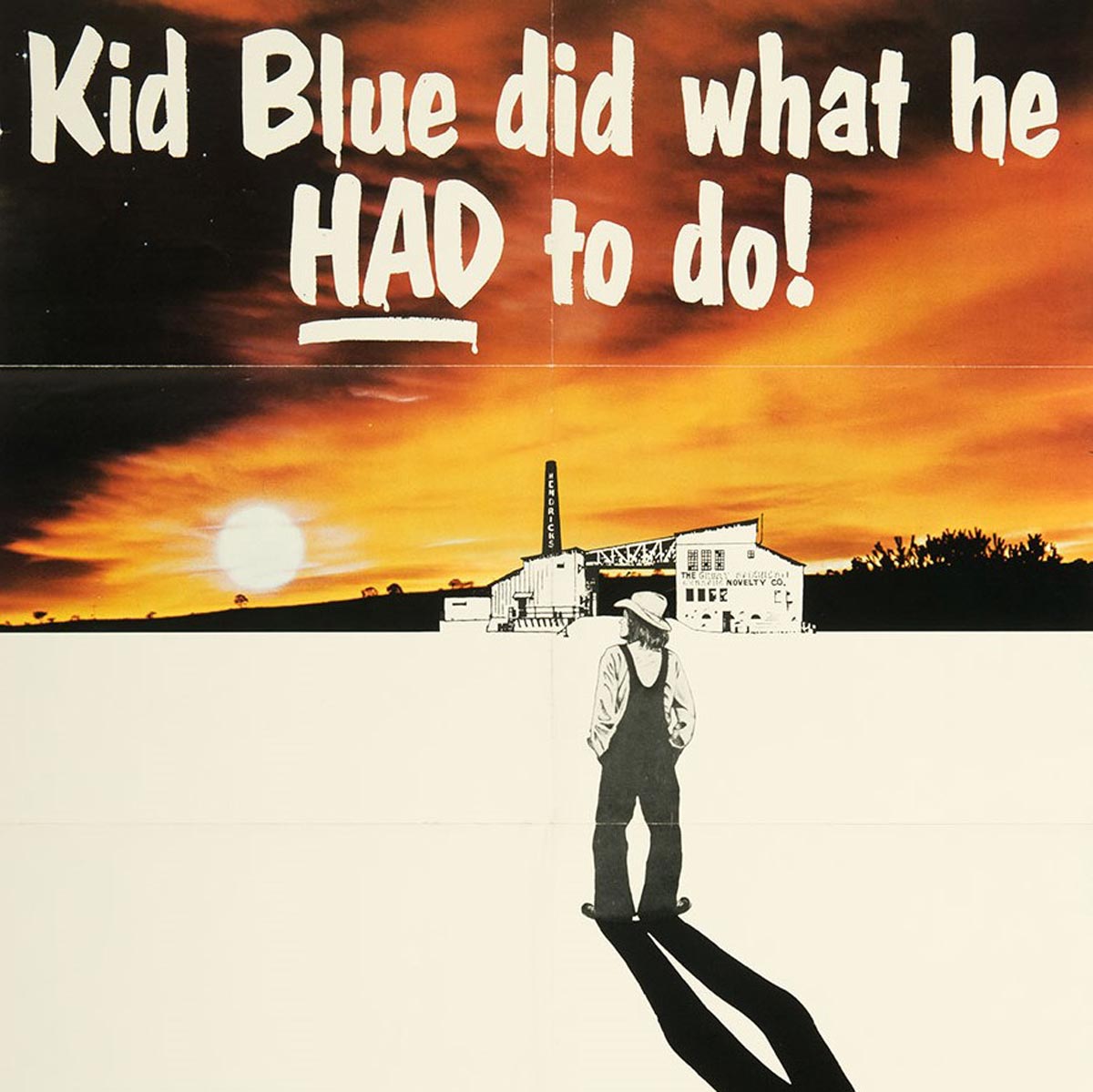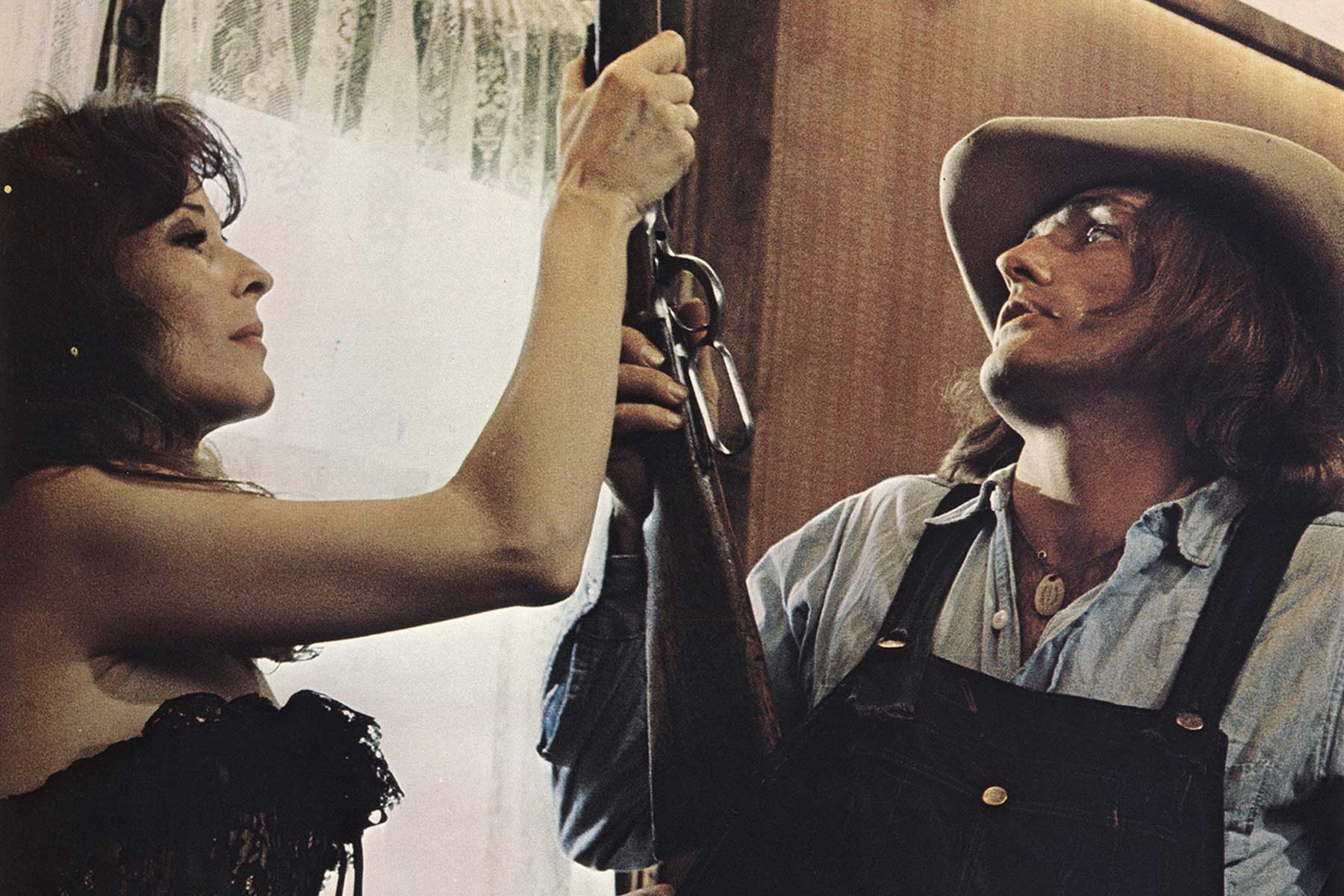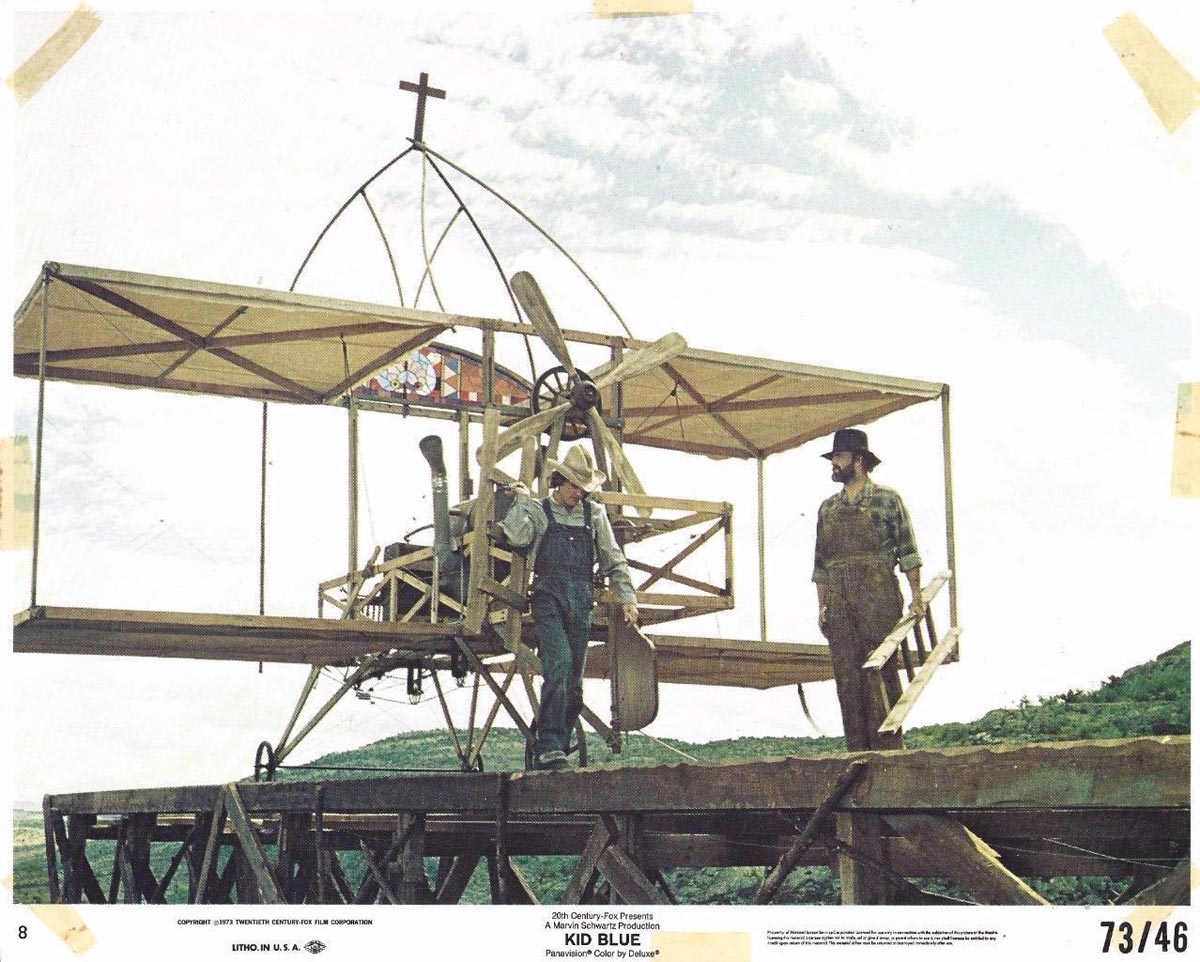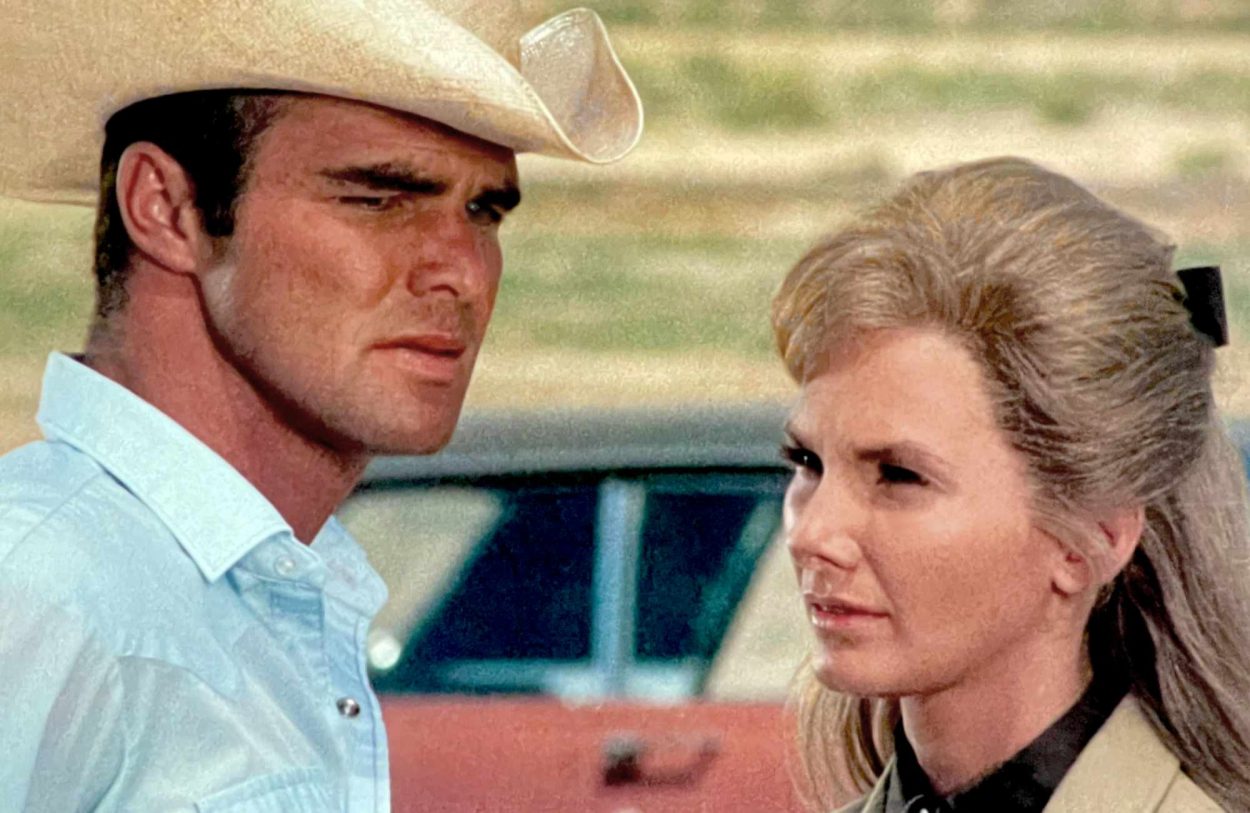“I can’t imagine a film set like that again… People leaping out of second story windows, people with blood running down them. I don’t know how a foot of that film ever got shot. There was certainly acid, incredible amounts of drinking, incredible amounts of insanity… I doubt there has ever been a film that crazy.” – Lee Purcell, talking about her experience on Kid Blue
James Frawley’s Kid Blue (1973) is a magnificent film that was far too difficult to see for far too long. There are multiple reasons for a film to be considered rare (lack of promotion, right film wrong time, limited release) and all of them contribute to a film’s disappearance from cinema culture. For a film like Kid Blue to be inaccessible for as long as it has been is really depressing, though the studio quietly, finally released the film as a manufactured-on-demand disc two years ago. The great thing is that Kid Blue is playing at the New Beverly this month and you can see it in 35mm!!
Usually when I research a title I can find a variety of information on the given work. But not Kid Blue. It was missing a key component and that fascinated me: there was little to nothing written on the actual content of the film. I located reviews from the time, interviews and biographical texts, but embarrassingly little parsing the film narrative. There are a few blog posts and recent discussions online but not many. Modern takes on the film are notably positive and seem to have resulted from a screening that the writer was lucky enough to attend. This seemed odd to me only because it is a 20th Century Fox film, it’s a counterculture Western and it has big stars in it: Peter Boyle, Dennis Hopper, Warren Oates, Ben Johnson, M. Emmet Walsh. Where is all the conversation?
This absence of film criticism and discussion about Kid Blue made me even more Sherlock Holmesy-curious about it. Until I found my answer: no one saw it and if they did? They didn’t remember it. Realistically, they may have been too stoned for much cinematic recall. But it’s such a good movie! C’mon people! As Susan Campo notes after the release, “the film all but disappeared, despite being picked up by the New York Film Festival and having a gala screening in Dallas on June 19, 1973.” Steven L. Davis corroborates this statement, “The movie made some money but did not linger in the public’s imagination. Though friends in Texas have steadfastly maintained over the years that Kid Blue is a cult classic, in truth the film has all but disappeared.”

While Vincent Canby’s New York Times review from 1973 was mostly negative, he still found the heart to say, “”Kid Blue” is a well-meaning, liberal, anti-fascist Western, dressed up with some good performances by Peter Boyle, Lee Purcell and Janice Rule.” He just found the commentary too heavy-handed. Perhaps it was. But if so, fuck it. Sometimes you need to just make a point. And the points made in Kid Blue are pretty important. It’s a very funny film. Kid Blue aka Bick Waner (Dennis Hopper) wants to go straight after being a bank robber/criminal but is constantly being told that he will never amount to anything. Sheriff “Mean John” Simpson (Ben Johnson) berates him at every turn as does Drummer (Ralph Waite), one of the residents of the boarding house Bick lives in. Bick finds solace in the friendships of Molly (Lee Purcell) and Reece (Warren Oates) Ford. While that relationship soon becomes complicated, so do Bick’s work relationships, leading to an identity crisis and a whole lot more!
Kid Blue is a fascinating look at racism, politics, violence and religion. The Native American characters are brutally honest and complex. Their dialogue, while comedic, resists the white supremacist discourse that is being had all around them while their physical actions disrupt the Manifest Destiny narrative. Some of this is subtle but it’s quite radical for a studio picture. It’s possible that this aspect of Kid Blue would have been seen as problematic to the head honchos, but I did not find any documentation one way or the other. The Hollywood Reporter, however, gave Kid Blue a rave review, calling it “both a counterculture protest film and a comic western film.”
Director James Frawley commented that 20th Century Fox just wasn’t pleased with the outcome. Apparently, they had been sold a different kind of film at the start. He said, “I think they wanted ‘Cat Ballou’ and when they got something closer to ‘McCabe & Mrs. Miller’ they were confused and a little angry.” Frawley was an old hand at political satire and social commentary having directed the TV show The Monkees for a number of years. He would later use his gifts to work with the incomparable Jim Henson on The Muppet Movie (1979). Clearly, Frawley had a knack for comedy with a hint (or more) of sarcastic glee.

But let’s rewind and go back to the making of the film. Because it’s insane. I am authentically unsure about how this film actually got made. It seems like the entirety of that set was a coked-out, gunned-up, hallucinatory lunatic asylum that only sobered up for enough time to shoot a scene.
Kid Blue was originally titled “Dime Box” but retitled by the studio because they thought it sounded like a drug reference. A man named Edwin “Bud” Shrake wrote it. Shrake, a New Beverly favorite, also penned the scripts for Arthur Hiller’s Nightwing (1979) and William Wierd’s Tom Horn (1980), both of which played the Bev earlier this year.
Shrake was more than a screenwriter. He was a journalist, sportswriter, Texan, and a crazy motherfucker. Hunter S. Thompson may be legend, but Bud Shrake and his compadres were no small potatoes. Thompson may have hung out with the Hells’ Angels and Ken Kesey, but Shrake and his crew were ready to take over a town, publish books about famous strippers and by the end of the Kid Blue shoot, their producer decided to leave Hollywood forever and become a monk.
Shrake was part of a Texan counterculture collective called Mad Dog, Inc., a group that co-founder Gary Cartwright described as “a rallying point for writers, artists, radicals, politicians, anyone who felt stifled by the times. The grander and more impossible an idea sounded the better Mad Dog liked it. We planned to open and distribute books and movies, open an all-night general store that sold 88 flavors of ice cream, and start a sanctuary for depressed greyhounds… Mad Dog really blossomed however when we traveled to Durango, Mexico for the filming of a screenplay Bud wrote called Dime Box.” Cartwright and the Mad Dog, Inc. crew drove down to “assist” their Mad Dog homie on the set. They were initially denied entrance to Mexico due to Mad Dog member Pete Gent’s long hair. Being a creative sort and quick thinker, Cartwright told Customs that they were shooting a religious film about Jesus. The Custom Agent quickly waved them through.
Bud Shrake wrote that making Kid Blue “was an experience that changed my life… we arrived in Durango and walked straight into a bizarre meeting at Dennis Hopper’s rented mansion where we found people on acid with pistols. And soon the chief narc of the district landed in a helicopter with armed soldiers and let us know our lives would swiftly get dangerous unless our producer, Marvin Schwartz, paid him $25,000 in protection money.”
Poor Marvin was in for a hellova time beyond paying off Mexican Officials. As usual in Hollywood, actors wanted to play with the script. Warren Oates considered his part “too homosexual” while Janice Rule wanted to shift the dynamic of her and Dennis Hopper’s seduction scene. These were minor inconveniences to the everyday battle of live non-prop firearms on-set. Oh yes, everybody had a gun at all times. And they were having shooting contests for… no reason. Just because they were drunk or stoned.

Then there was the Dennis problem. While Schwartz had hired a special stuntman to be Hopper’s “caretaker” (more or less) he couldn’t always manage. Hopper was always hanging out with Mad Dog, Inc. folks, smoking dope or drinking tequila. When he got in front of the camera, he was fine. But it was still critical to watch out for Dennis and his drunk or high antics, especially with the knowledge that he kept a loaded pistol hidden in his pocket or boot at all times.
During the first week of shooting Kid Blue, Marvin hosted a party at his place, the first of many. Hopper barreled into the house, begging to speak with Schwartz, Frawley, and Shrake. He told them, “You can’t make the movie, man! Everyone’s gotta leave Mexico now. There’s gunfire in the streets…I almost didn’t get here alive. It’s total panic and chaos and hysteria out there right now. People are getting killed right and left. The fucking noise, it’s like World War II out there!” After a brief investigation, the situation was sorted out. As luck would have it, there was no Mexican Revolution in the streets. Kid Blue could continue shooting. Hopper had simply dropped acid and gone to a local carnival. This was Week One.
Brave Marvin Schwartz held out until the bitter end. Not only did he deal with crazy actors, political corruption and countercultural artists but he also had to handle Studio Politics. I wouldn’t have wanted to be this guy for anything in the world.
20th Century Fox was in the middle of a regime change, during the shooting of Kid Blue making Marvin’s life even more hellish. Studio Head Daryl Zanuck had green lit the project in 1971, but but was out by 1973 (date of release), replaced by new studio dead Alan Ladd, Jr. The film (and Schwartz) suffered as a result. The title change (from Dime Box to Kid Blue) was a nightmare and finally drove Schwartz to call Bud Shrake and tell him, “I’ve lost the last fight that I’m going to lose over this movie. I can’t possibly lose any more fights, because as I look out the window right now, I can see they are painting my name out of my parking space. They’re going to haul my car off the lot, and that banging noise you hear is the people moving my furniture and stuff out of my office. We’ve just been bodily thrown off the lot. This movie is going to be called Kid Blue.” Schwartz then proceeded to leave the film industry altogether and became a Buddhist monk in India, calling himself Brother Jonathan.
Despite all the off-screen craziness and absurd conduct, drug-filled get-togethers and events full of “lethally laced” pot cookies, cocaine and “homemade vanilla-flavored LSD,” Kid Blue was indeed shot, edited and released! It was likely a limited release, playing some of the larger cities like LA, NY, Boston, Dallas and a few other urban hubs, but it did get some play. It just got zero support from the studio, no push from advertising or PR and thus died a sad lonely death on its first time out, disappearing as quickly as it appeared.
So come to the New Beverly and watch Kid Blue. Bring a pal. This film’s a keeper and certainly deserves another shot on the big screen with an appreciative audience.


